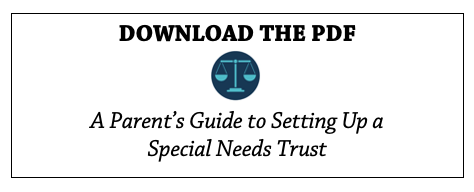 The establishment of a special needs trust can provide a false sense of security that you are all set.
The establishment of a special needs trust can provide a false sense of security that you are all set.
The money that funds the trust will secure the resources for your loved one to be cared for.
What is a special needs trust?
A Special Needs Trust (SNT) is a legal document and a very important part of your child's long-term financial plan.
The trust may be used to hold money:
- that you save
- that others give your child as gifts
- that you receive from an insurance settlement
Funds in the SNT will not interfere with your child's eligibility for federal benefits like Medicaid and Supplemental Security Income (SSI).
Who are the parties involved?
The individual who funds the trust is the Donor. The individual who benefits from the trust is the Beneficiary. The individual who oversees the trust is the Trustee.
Regardless of the timing decision for funding the trust, it is important to do whatever you can to makes sure there will be adequate money in the trust to provide for your child’s security.
There are two steps:
- identify what the anticipated needs will be
- assess what steps you can realistically take to provide what is necessary in light of your other financial requirements and goals.
Special Considerations for Life Insurance in Special Needs Planning
The use of life insurance in special needs planning is somewhat different than in traditional planning . It is critical to plan for the financial problem of one of the most catastrophic events in life; a parent’s death.
In planning for a traditional family, often the largest amount of life insurance protection is purchased for the wage-earning parent. Following this same strategy is one of the most common errors a family with special needs tends to make. One cannot assume there is no financial value lost in the event of death of the primary caregiving parent. Although it is difficult to place a financial value on the parent that does not work outside of the home, or provide the majority of the income to the family, it is critical to account for this value. This often means that you have to look at each parent to determine the human life value. This is ultimately converted to a dollar value to determine the life insurance protection needed.
Income Replacement:
In the traditional planning model, the amount of life insurance needed is often simplified to be a function of the annual income. For example, to determine the life insurance need of a wage earner, a simple technique is to multiply your annual earnings by 5 or 10 times or the number of years you want to ensure that income for your family is continued. This means tht if you earn $100,000 per year, you should have from $500,000 to $1,000,000 of life insurance protection. A more detailed approach would be to complete a capital needs analysis. This is the analysis that most life insurance professionals and financial planners use. This calculation involves determining the present value of money needed to pay for short-mid-and long-term goals a family identiifies. For families with special needs, insurance coverage requirements often extend well beyond the traditional family's timeline fo having enough money to support children through their school years. Special needs planning requires planning for two generations, anticipating a possible need to support the child with disabilities beyond the school years and throughout his or her life.
In special needs planning, the first step in determining life insurance needs is to determine the loss of income to the household with the death of a parent. Next it is important to identify the expenses that will continue upon the death of that parent, particularly money needed to address future family goals. Looking at income alone can be misleading because variations in saving and spending affect planning. In the event that a family spends a larger percentage of their monthly income, they have two options:1. to insure for this larger amount to maintain the family lifestyle, or 2.to anticipate lifestyle changes required by the family due to a decrease in income after the death of a parent. For families who are diligent at saving for their future – for retirement, education, supplemental needs, etc. – a loss of income may prevent the ability to maintain this saving pattern. Families must address issues of both current spending to maintain their lifestyle and their savings and investments for the future.
The other common error in purchasing life insurance is buying only term life insurance. Term insurance is life insurance that is designed to last for a predetermined number of years, such as 5,10, 20 or possibly 30 years if applied for at an early age. Term insurance works in the event that the need for protection is for only a temporary period of time. In special needs planning, the “need” is not temporary – it is permanent. As we have discussed, the need to address that second generation of financial issues comes into play once again. There may be a need for permanent life insurance protection, rather than term life insurance that only lasts until the children have grown in 20 years. A recommended strategy is to acquire a combination of both term and permanent insurance.


